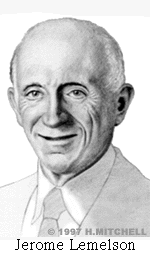Jerome Lemelson
Jerome H. Lemelson (1923-1997) was one of the most prolific American inventors of all time. His inventions, for which he amassed more than 500 patents, include essential parts of dozens of products in common use today, including the VCR, camcorder, Walkman®, cordless phone, fax machine, data and word processing systems, and industrial robots.
Born in 1923, Jerome Lemelson was already inventing as a child. One early effort was a lighted tongue depressor, which he invented for his father, a physician. Later, youthful experiments with model airplanes evolved into a more serious role as a designer of defense systems for the U.S. during World War II, and three degrees in engineering from New York University (1947, 1949, and 1951).
Soon thereafter, Lemelson began his over 40-year career as an independent inventor. Like many inventors, he first focused on toys and novelties, but the nascent computer age inspired him with more serious ideas. From 1954 to 1956, Lemelson applied for his first automation patents, including his "machine vision" system. This combination of computers, robotics, and electro-optics allows assembly-line robots to assess an item and determine what work needs to be done to it, adjust themselves to perform multiple operations on the item, and even do quality control of the work when it is done.
In the 1960s, Lemelson began to land licensing offers for his industrial ideas, including an automated warehouse system. In 1974, he licensed the audio cassette drive mechanism that made the Walkman® possible to Sony. In 1977, ironically, his first patent application for the camcorder was rejected. The examiner considered portable video recorders an impossibility! In 1981, IBM bought about 20 Lemelson patents for data and word processing systems.
All the while, Lemelson was inventing. Famous for the idea notebooks that he carried with him, he was inspired with ideas in the middle of conversations and even in his sleep. But financial success allowed Lemelson to pursue the promotion of American invention as a whole.
Lemelson served on a federal Advisory Committee on patent issues from 1976 to 1979. He was a tireless promoter of independent inventors' rights, defending the "first to invent" rather than the "first to file" patent system. Lemelson and his wife Dorothy founded the Lemelson Foundation in 1994, whose many programs share the twin goal of promoting and rewarding American invention and innovation. The Foundation has established the Lemelson Center for the Study of Invention and Innovation at the Smithsonian Institution's National Museum of American History, an extensive, interactive exhibit that informs and inspires especially young people about the importance of innovation in the U.S. The Foundation also funds the Lemelson-MIT Program at the Massachusetts Institute of Technology, which sponsors numerous activities, from the national Lemelson-MIT Student Prize for collegiate students, to InvenTeam grants for teams of high school students, to several K-12 invention education initiatives.
Over a period of more than 40 years, Lemelson received, on average, one patent every month. Through both his success and his greater commitment to American invention, Lemelson's legacy will live on.


